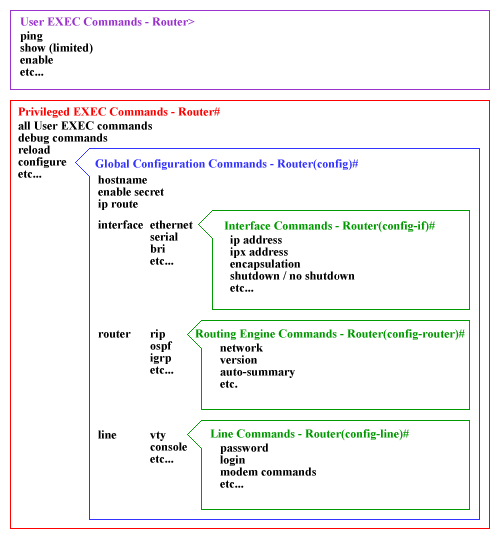

As a security feature, Cisco IOS® Software separates EXEC sessions into two different access levels: user EXEC level and privileged EXEC level. User EXEC level allows you to access only basic monitoring commands; privileged EXEC level allows you to access all router commands. Privileged EXEC level can be password protected to allow only authorized users the ability to configure or manage the router. From privileged EXEC level, you can access all the command modes. There are five command modes: global configuration mode, interface configuration mode, subinterface configuration mode, router configuration mode, and line configuration mode.
After an EXEC session is established, commands within Cisco IOS Software are hierarchically structured. Understanding this hierarchy is important for successfully configuring a router. The following figure illustrates a simple high-level schematic diagram of some Cisco IOS commands. This figure summarizes the different modes you will explore in the Interface Labs in a later section.

Command options and applications vary, depending on your position within this hierarchy. Configuration command options are not available until you have navigated to the configuration branch of the Cisco IOS command-line interface (CLI) structure. When you are in the configuration branch, you may enter system-level configuration commands that apply to the entire router at the global configuration level. Interface-specific configuration commands are available when you switch to the interface configuration level. More detailed information and examples of how to navigate through the Cisco IOS CLI hierarchy are offered in the router configuration labs that follow in a later section of this module.
To assist you in navigation through the Cisco IOS CLI, the command prompt changes to reflect your position within the command hierarchy. This setup allows you to easily identify where within the command structure you are at any given moment. The following table is a summary of command prompts and the corresponding location within the command structure.
| Router> | - User EXEC mode |
| Router# | - Privileged EXEC mode |
| Router(config)# | - Configuration mode (notice the # sign indicates this is accessible only at privileged EXEC mode) |
| Router(config-if)# | - Interface level within configuration mode |
| Router(config-router)# | - Routing engine level within configuration mode |
| Router(config-line)# | - Line level (vty, tty, async) within configuration mode |
![]()
![]()
Now that you are familiar with all the router modes, go to Lab: Navigating the Cisco IOS Architecture.
| Important Notices Privacy Statement. |